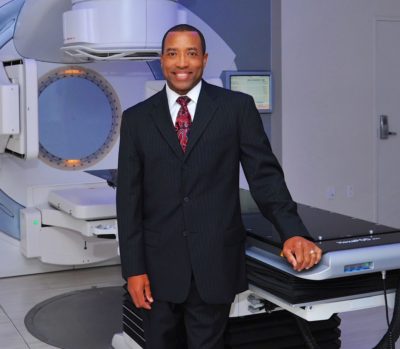
How common is prostate cancer? About one man in eight will be diagnosed with prostate cancer during his lifetime. It is the most common cancer and the second leading cause of death in men after lung cancer, according to Dr. Luther Ampey, a radiation oncologist at MedStar Montgomery Medical Center in Olney.
Cure rates “Despite its prevalence, about 80 percent of cases are caught in an early stage, which is highly curable, greater than 90 percent,” Dr. Ampey says. According to American Cancer Society estimates, “we have roughly 225,000 new diagnoses a year and only about 30,000 deaths.” Dr. Ampey also cited a study that monitored men from 2011 to 2017 and determined that 97 percent of them were surviving after five years.
Advanced stage When prostate cancer has spread to other regions of the body it is called metastatic. “Unfortunately, we can’t cure it, but we can prolong a decent quality of life using systemic therapies which might include chemotherapy, immunotherapy and radiation,” Dr. Ampey says.
Slow growing Prostate cancer is slow growing in mostly aging men. It can take years to become large enough to be detectable and even longer to metastasize outside the prostate, he says.

Screening The PSA test is a blood test used primarily to screen for prostate cancer. The test has enabled medical professionals to catch prostate cancer early when they are no symptoms, Dr. Ampey says. The test is not without controversy. “You might tend to over-diagnose and over-treat,” he says.
Dr. Ampey has participated in screening programs at community centers and churches. “For the most part, patients who are more educated, who have access to health care are more likely to get screened.”
Red flags “Men should watch for changes in urinary habits, increased frequency of urination, burning, blood in urine or blood in semen. They can be signs of prostate cancer, but more often it’s indicative of inflammation or infection.”
Treatment. Using different types of radiation, some patients can be treated in five weeks or one week, he says. “There are some who we just watch, who might just get their PSA followed and get periodic biopsies to make sure there’s no changes,” he says. “Many of the treatments we do offer, including radiation, are extremely well tolerated and without significant side effects.” The most common surgery for prostate cancer removes the entire prostate gland. It can cure prostate cancer if the disease hasn’t spread outside the prostate gland.
Prevalance “The older a man gets the more likely he is to be diagnosed with prostate cancer, with the average age being in the mid-60s. In some cases there may be a genetic or hereditary factor.” African American men both get and die from prostate cancer at a higher rate, Dr. Ampey says. They are 1.7 times more likely to be diagnosed and 2.1 times more likely to die from prostate cancer than non-Hispanic white men, according to the U.S. Department of Health and Human Services. “The reasons are complex and not fully understood,” Dr. Ampey says.
Prevention Diet and weight control are important factors, Ampey says. “We want to have a healthy diet – low fat, high fiber. Selenium and lycopene have been associated with a decreased risk of prostate cancer,” he says. “If aging men are living healthy lives and getting their check-ups, they all have opportunity to have disease found at an early stage.”
Advances in treatment “There’s work being done in the metastatic or late-stage disease to turn prostate cancer into more of a chronic disease, one that we can treat that you can live with and have a good quality of life.” Surgically, Dr. Ampey says, “there have been a number of advances where patients can have a better preservation of urinary and sexual function.”




